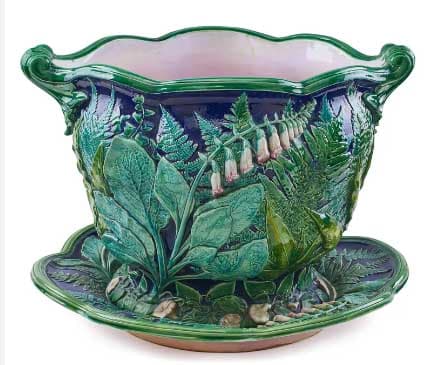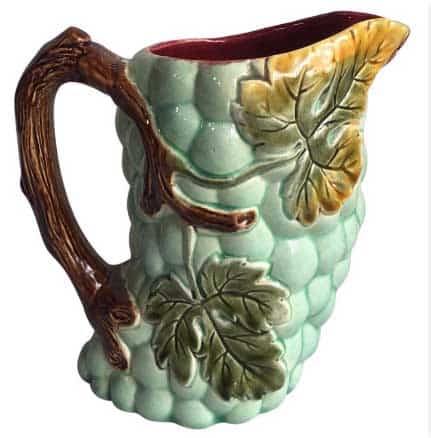
Are you looking to start a collection of antique majolica? If so, you have come to the right place. This comprehensive guide will cover all the basics you should know about collecting antique majolica, from its origins to how to spot authentic pieces. Read on to learn more about this unique and beautiful art form.
What is Antique Majolica?
Antique majolica is a type of decorative pottery that was popular in Europe and the United States in the 19th and early 20th centuries. The term “majolica” refers to Majolica pottery that has its origins in the Italian city of Faenza. It was first developed by the Italian potter Nicola da Urbino in the mid-15th century. Da Urbino was inspired by the traditional pottery of the Spanish island of Majorca, which is where the term “majolica” comes from.
Majolica became popular in Europe and the United States in the 19th century, and it was often used to produce a wide range of decorative items. Antique majolica is now highly prized by collectors for its decorative appeal and historical significance. It is often sought after for its intricate designs, bright colors, and unique glaze, and it can be found in a variety of forms, including vases, plates, figurines, and other decorative items.
Types & Makers of Antique Majolica
Antique majolica pottery can be divided into three main types: English, Continental, and American. Each type of majolica has its own distinct characteristics and designs.
English Majolica Makers: Minton & Co, Wedgwood, George Jones
American Majolica Makers: Griffin Hill Smith & Co
Continental Majolica
Continental majolica is a term used to refer to decorative pottery that was produced on the European continent in the 19th and early 20th centuries
France: Luneville, Sarreguemines, Longchamp, Massier, Palissy
(Palissy majolica is a type of decorative pottery that was produced in France in the 19th century. It is named after the French potter Bernard Palissy, who is credited with creating the first examples of this type of pottery in the mid-19th century)
Germany: Villeroy & Boch, Schramberg,
Sweden: Rorstrand, Gustafsberg
Czechoslovakia: Eichwald
How to Spot Authentic Antique Majolica

When it comes to collecting antique majolica, it’s important to be able to spot authentic pieces. Authentic majolica is typically marked with the maker’s name, as well as a date. It is also important to look for signs of aging, such as crazing, or a dulling of the glaze. It is also important to look for signs of damage, such as chips or cracks.
Top Tips for identifying genuine antique majolica:
- Check the glaze carefully as antique authentic majolica is very colorful, glazes will have a rich, lustrous color hue as opposed to modern reproductions that will be much more garish in colour. Genuine old majolica glazes are exceptional whereas newer replicas will have signs of glaze runs, drips or just look amateur.
- Antique majolica will have a certain weight to it. They are heavy pieces
- The most usual ground colours of antique majolica were a dark underglaze blue and a brighter, overglaze ; also used were turquoise blue, yellow, green, and rose Pompadour. More modern pieces will most likely have a white underglaze.
- Check the bases for signs of wear and age. Antique majolica pieces will show there use o the rim of the bases where they have been moved over the years. Some will have makers marks but some wont so checking the wear is the best option.
Famous Majolica Pieces & Artists
There are many well-known pieces of majolica and many famous artists who have created unique and beautiful pieces. Here are some of the most famous pieces and artists:
· The “Majolica Vase” by French artist Charles-Henri-Joseph Cordier.
· The “Majolica Plate” by English artist William Greatbatch.
· The “Majolica Phoenixville” by American artist Charles Fenton Mercer.
· The “Majolica Frog” by German artist Paul Scheurich.
· The “Majolica Fruit Bowl” by Austrian artist Carl Thieme.
Collectors of Antique Majolica

Collecting antique majolica is a popular hobby among many ceramic art enthusiasts. There are many collectors who specialise in majolica, and there are even clubs, societies and organizations dedicated to finding and preserving pieces of majolica.
If you are looking to start a collection of antique majolica, there are many resources available to help you. There are websites and blogs dedicated to collecting and preserving antique majolica, as well as books and magazines about the subject.
Conclusion
If you are looking to start collecting antique majolica, visit Antiques Store Bournemouth to find a great selection of authentic pieces. With our wide selection and expert advice, you are sure to find the perfect piece for your collection
